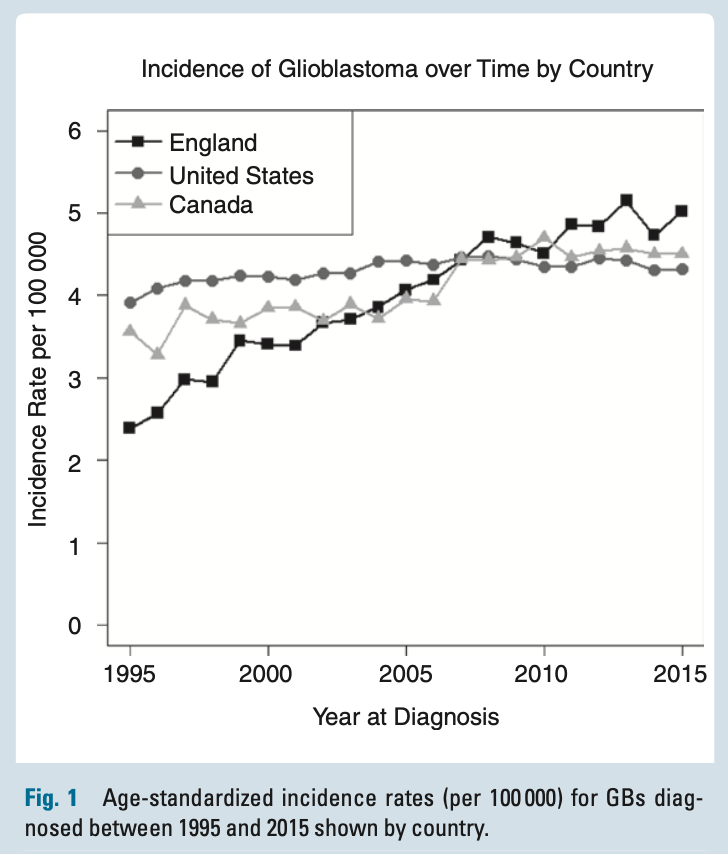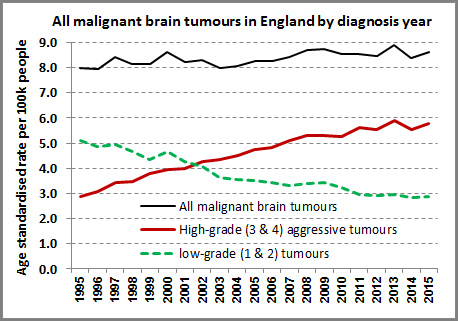The incidence of glioblastoma multiforme, GBM, the most aggressive type of brain tumor, though rising slowly over the last 20 years, has not jumped up in the U.S. and Canada, as it has in England and a number of other northern European countries, according to a new analysis of national brain tumor registry data.
Between 1995 and 2015, GBM rates went up 10% in the U.S. and 26% in Canada. In contrast, the increase in England over the same period was 110%.
The new analysis, led by Faith Davis of the University of Alberta, Canada, and published in a letter to Neuro-Oncology, shows that GBM rates in all three countries have been converging since 1995 and are now quite similar. In 2015, the rates were: 4.32 in the U.S., 4.50 in Canada and 5.02 in England, per 100,000 persons per year.

Source: Neuro-Oncology, November 30, 2019
The incidence data are from the Brain Tumour Registry of Canada and the Central Brain Tumor Registry of the United States (CBTRUS).
In a letter to Neuro-Oncology, Davis and colleagues argue that the historical disparity between trends in North America and England “is most likely due to factors related to improved data collection practices in surveillance systems.”
The joint U.S.-Canadian analysis was prompted by a paper and an accompanying letter, both published last year, by a team led by Alasdair Philips. They showed that GBM had more than doubled in England and attributed the increase to one or more “widespread environmental or lifestyle factors.” Among the possible risk factors were radiation from mobile phones, CT scanners and nuclear fallout, as well as radon and air pollution. Philips, an independent researcher, lives in Scotland.
Davis writes that, given that the rates among the countries are now similar, it would be “premature” to attribute past incidence rate patterns to any environmental factor.
One aspect of the English data is left unanswered by Davis’s letter: Philips showed that the incidence of low-grade brain tumors was decreasing as that of GBM was increasing, netting little change in the overall rate of all malignant brain tumors (see figure below). Davis did not address trends for low-grade tumors.
 Source: Alasdair Philips
Source: Alasdair Philips
Davis concludes:
“We agree with Philips et al. that accurate data for all countries, including documentation of reporting practices, are needed as we work toward understanding emerging patterns of brain tumor incidence rates.”
In an interview, Philips welcomed the new analysis, commenting, “There appears to be a difference between Europe and North America, and I agree with Faith Davis that we really need to find out why.” Davis could not be reached for comment.
In addition to England, GBM have also been increasing at higher than expected rates in Denmark, France and Sweden.
Jill Barnholtz-Sloan of Case Western Reserve medical school is one Davis’s coauthors. Her research group has regularly presented the latest CBTRUS data in Neuro-Oncology. Here are the 2018 and the 2019 reports (both open access).
https://microwavenews.com/news-center/gbm-us-canada-england
Spread the word:
- Click to share on Facebook (Opens in new window)
- Click to share on Twitter (Opens in new window)
- Click to share on WhatsApp (Opens in new window)
- Click to share on LinkedIn (Opens in new window)
- Click to share on Pinterest (Opens in new window)
- Click to share on Reddit (Opens in new window)
- Click to share on Tumblr (Opens in new window)
- Click to share on Telegram (Opens in new window)
- Click to print (Opens in new window)


